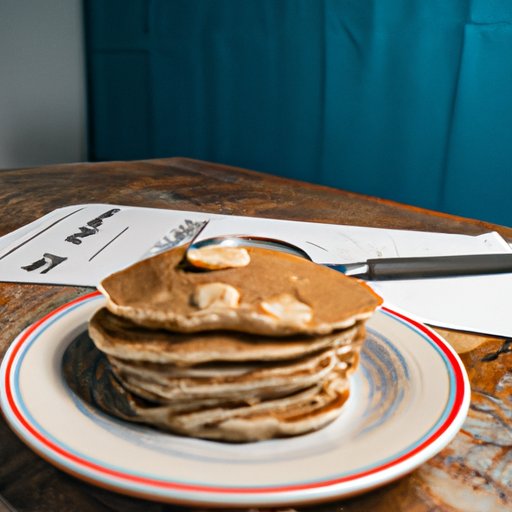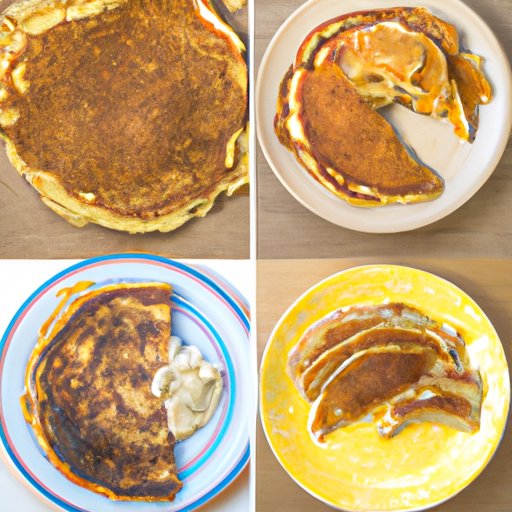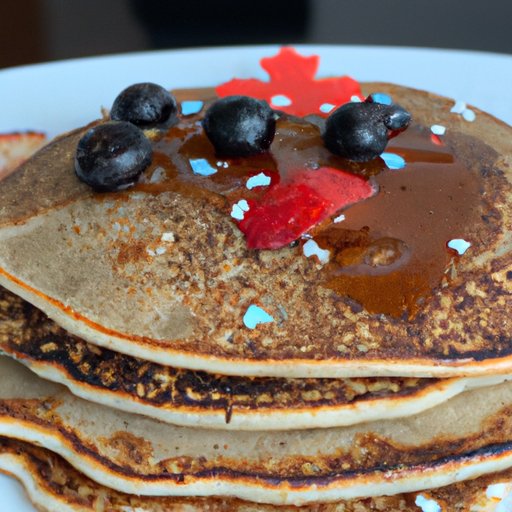Introduction
Pancakes are a beloved breakfast treat around the world, but are they healthy? The answer isn’t as straightforward as it may seem. In this article, we’ll explore the nutritional content of pancakes, examine healthier alternatives, and investigate how pancakes fit into a balanced diet.

Analyzing the Nutritional Benefits of Pancakes
The nutrient content of pancakes varies greatly depending on what ingredients are used. Traditional pancakes made from white flour, milk, butter, and sugar contain calories, fat, protein, carbohydrates, and small amounts of vitamins and minerals. According to the USDA, one large pancake (4-inch diameter) contains approximately:
- Calories: 103
- Fat: 2.3 grams
- Carbohydrates: 19.8 grams
- Protein: 2.6 grams
The impact that pancakes have on overall health depends largely on the ingredients used and the amount consumed. While some nutrients in pancakes can be beneficial, such as calcium, iron, and B vitamins, too much fat and sugar can have a negative effect on health. According to Dr. Steven Masley, MD, “If you eat a stack of pancakes, you’re getting a lot more calories and carbohydrate than you need for breakfast, and not enough fiber or healthy fats.”
Examining the Healthier Alternatives to Pancakes
Fortunately, there are healthier ways to enjoy pancakes. Replacing white flour with whole grain flour can provide additional nutrients and dietary fiber. Additionally, using egg whites or vegan substitutes instead of whole eggs can reduce the fat and cholesterol content. Here are some healthier pancake recipes to try:
- Whole Grain Pancakes: Combine 1 cup of whole wheat flour, 1 teaspoon baking powder, ½ teaspoon baking soda, ¼ teaspoon salt, and 1 tablespoon of honey or maple syrup. In a separate bowl, mix together 1 cup of buttermilk, 1 egg, and 1 tablespoon of melted butter. Add the wet ingredients to the dry ingredients and stir until well combined. Cook the pancakes on medium heat until golden brown.
- Egg White Pancakes: Whisk together 1 cup of all-purpose flour, 1 teaspoon baking powder, ½ teaspoon baking soda, and ¼ teaspoon salt. In a separate bowl, combine 1 cup of skim milk, 2 egg whites, and 1 tablespoon of melted butter. Add the wet ingredients to the dry ingredients and stir until just combined. Cook the pancakes on medium heat until golden brown.
- Vegan Pancakes: Mix together 1 cup of all-purpose flour, 1 teaspoon baking powder, ½ teaspoon baking soda, ¼ teaspoon salt, and 1 tablespoon of maple syrup. In a separate bowl, whisk together 1 cup of almond milk, 1 teaspoon of apple cider vinegar, and 2 tablespoons of melted coconut oil. Add the wet ingredients to the dry ingredients and stir until just combined. Cook the pancakes on medium heat until golden brown.

A Comparison of Traditional Pancakes and Healthy Variations
To better understand the difference between traditional pancakes and healthier variations, let’s take a look at the calorie, fat, and carbohydrate content of each:
- Traditional Pancakes: 103 calories, 2.3 grams of fat, and 19.8 grams of carbohydrates per 4-inch pancake.
- Whole Grain Pancakes: 118 calories, 3.2 grams of fat, and 22.1 grams of carbohydrates per 4-inch pancake.
- Egg White Pancakes: 99 calories, 1.7 grams of fat, and 18.7 grams of carbohydrates per 4-inch pancake.
- Vegan Pancakes: 110 calories, 5.3 grams of fat, and 17.9 grams of carbohydrates per 4-inch pancake.
As you can see, the calorie, fat, and carbohydrate content of traditional pancakes is relatively similar to that of healthier variations. However, the additional nutrients found in these recipes make them more nutritious overall.

Exploring the Impact of Toppings on the Healthiness of Pancakes
When it comes to toppings, there are both healthy and unhealthy options. Sugary toppings such as chocolate chips, sprinkles, and syrups can quickly turn a healthy breakfast into an unhealthy one. On the other hand, adding nutrient-dense toppings such as fresh fruit, nuts, and yogurt can boost the overall nutrition of pancakes.
Investigating How Pancakes Fit into a Balanced Diet
Pancakes can fit into a balanced diet if enjoyed in moderation. Adding nutrient-dense toppings can help to make pancakes healthier, but it’s important to remember that even healthy pancakes should be eaten in moderation. As registered dietitian Kristin Kirkpatrick explains, “Balance is key when it comes to eating pancakes and other treats. Enjoying them in the context of a healthy diet full of nutrient-rich fruits, vegetables, and lean proteins will ensure that your pancakes don’t become a diet disaster.”
Conclusion
In conclusion, pancakes can be part of a healthy diet if enjoyed in moderation and with nutrient-dense toppings. There are also healthier alternatives to traditional pancakes that can provide additional nutrients and dietary fiber. Ultimately, the healthiest option will depend on individual needs and preferences.
By understanding the nutritional content of pancakes and exploring healthier alternatives, it’s possible to enjoy this breakfast favorite without compromising health. With a little creativity and some nutrient-dense toppings, pancakes can be part of a balanced diet.
(Note: Is this article not meeting your expectations? Do you have knowledge or insights to share? Unlock new opportunities and expand your reach by joining our authors team. Click Registration to join us and share your expertise with our readers.)
